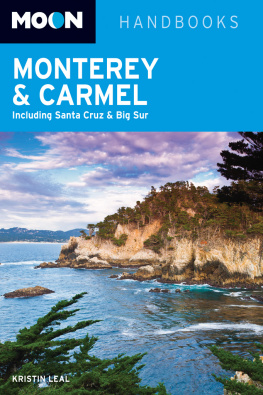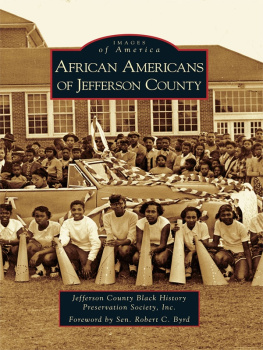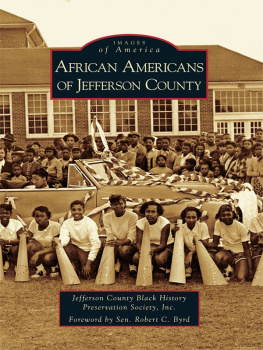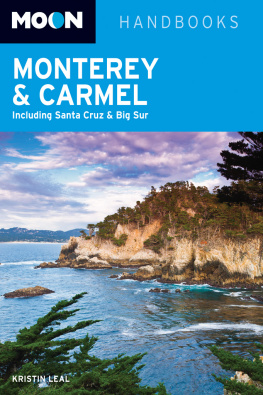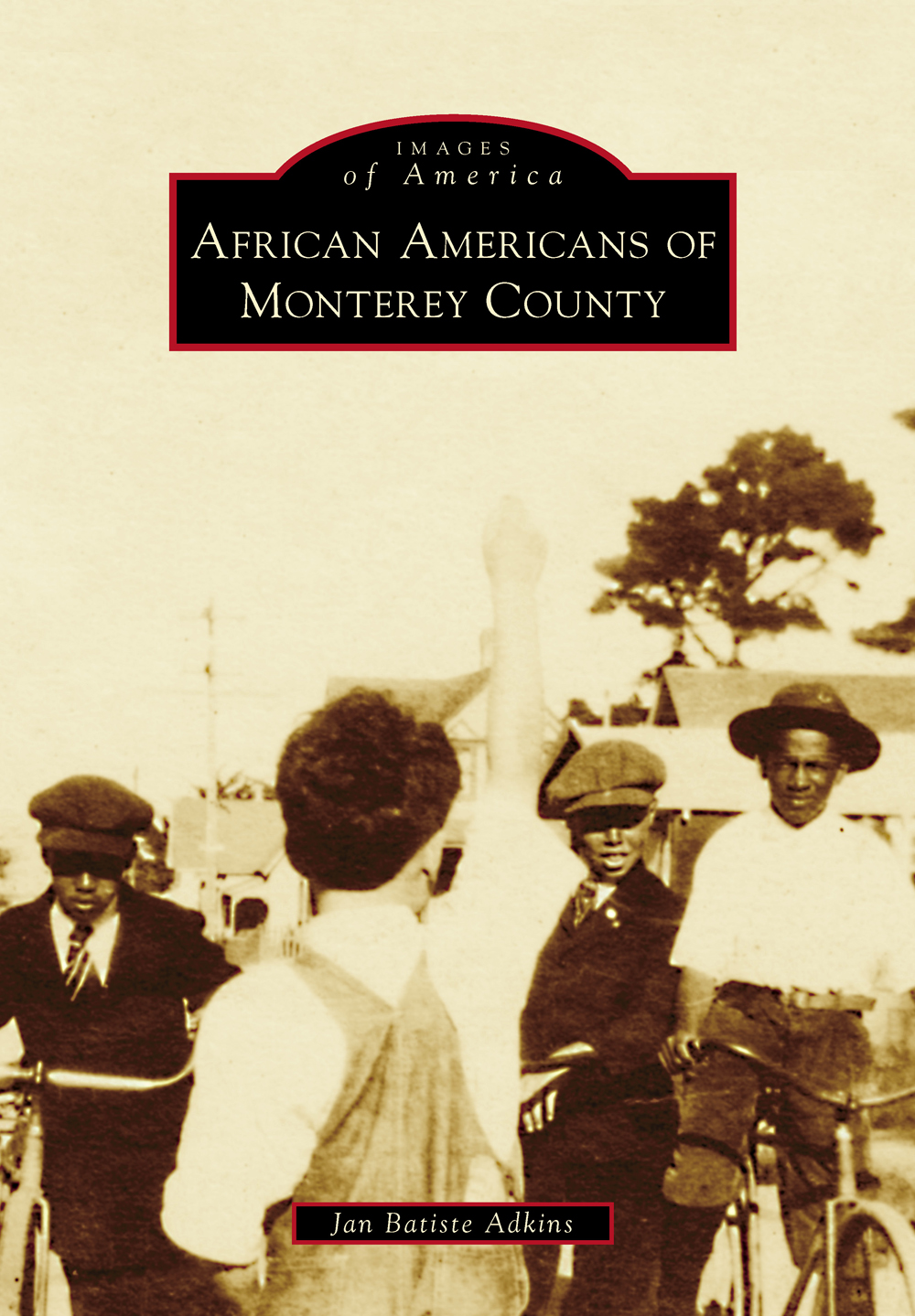
IMAGES
of America
AFRICAN AMERICANS OF
MONTEREY COUNTY
ON THE COVER: The photograph, taken around 1918, depicts African American boys riding bicycles in their neighborhood of Pacific Grove. They are the sons of Rutherford and Minnie Walker of Pacific Grove. For many children, Monterey has provided open space and freedom to roam and play. African Americans since before the 20th century have migrated to Monterey County for its rich environment and opportunities for land, jobs, homes, and successful family life. (Courtesy of Marguerite McSween Fearn.)
IMAGES
of America
AFRICAN AMERICANS OF
MONTEREY COUNTY
Jan Batiste Adkins

Copyright 2015 by Jan Batiste Adkins
ISBN 978-1-4671-3260-2
Ebook ISBN 9781439649053
Published by Arcadia Publishing
Charleston, South Carolina
Library of Congress Control Number: 2014941576
For all general information, please contact Arcadia Publishing:
Telephone 843-853-2070
Fax 843-853-0044
E-mail
For customer service and orders:
Toll-Free 1-888-313-2665
Visit us on the Internet at www.arcadiapublishing.com
This book is dedicated to the families of Monterey County, especially students seeking information about the evolution of African American communities throughout Monterey County.
CONTENTS
ACKNOWLEDGMENTS
I am extremely grateful to the many people who have made this book possible. First, I would like to thank the librarians and archivists who provided historical research, consultation, and images for this project: archivist Dennis Copeland of the Monterey Public Library, archivists James Perry and Barbara Brown of the Monterey Historical Society, archivist Sheila Prader of the San Benito County Historical Society, and librarians at the Monterey Free Libraries, Salinas Steinbeck Library, and Castroville Library.
The most essential elements in this book belong to the more than 50 family members who have invited me into their homes to hear their family stories and discuss local history. I especially thank family members of the African American pioneer families for sharing their migration stories and photographs: Marguerite McSween Fern, Douglas Sutton, Mary Ellen Harris, and Wellington Smith Sr. family members. I thank Velma Evans for the many hours spent sharing her family stories during the precious last hours of her life. I have gratitude for Agnes Tebo and Ethel Kelly for telling their family stories of migration from Louisiana and Texas to Salinas in search of a home near the bay.
I am eternally grateful to a few friends who served as invaluable resources for this book: Helen Rucker, for her wisdom and knowledge of political and community issues; Leah Washington, for her professional knowledge of photography; Susan Shillinglaw, for her invaluable ideas, suggestions, and contacts; and Jean Crawford, for joining me on this journey, assisting with the layout, and just being available for advice. Most of all, I want to thank my husband and driver, Walter Adkins, who traveled with me to the many interviews throughout Monterey County, sharing his wisdom. I also want to thank my family members who have supported me during some of the more challenging moments: Jittaun, Christopher, and Christina. I have established many new friendships on my journey of discovering the history of African Americans of Monterey County, whose friendship I will continue. Thank you so much for sharing your family stories and providing a better understanding of life for African Americans in the communities of Monterey County since before the beginning of the statehood of California.
INTRODUCTION
Unknown to many, African Americans have journeyed to communities in Monterey County to explore, work, or establish homes since as early as the 18th century. African Americans of Monterey County examines the history of black explorers, adventurers, and pioneers of the 18th and 19th centuries. Further documentation was done through oral interviews and family stories and photographs of the migration of African Americans in the 20th century to the Monterey Peninsula. This book explores the establishment of a sense of community for African Americans throughout Monterey County. The history of African Americans in Monterey will add to the established history of other ethnic communities within the peninsula and the Salinas Valley. This book depicts the journey of African Americans with the common goal of establishing communities in Monterey County where families could flourish. The story begins with the first known person of African heritage to journey to Monterey.
Since Fr. Junipero Serra led soldiers and priests and Native peoples from Baja to the Monterey Peninsula in 1769, people from various countries have migrated to communities in Monterey County, which was at that time considered Mexican territory. Several African ship workers, such as caulkers (ship maintenance), were aboard a ship during his expedition. Those Africans helped build the Mission of Carmel, among them Alejo Nino. Following Alejo Nino in the 1770s, two governors of the Mexican territory of Alta California in the mid-1830s, Lt. Col. Manuel Victoria and Pio Pico, were of mixed blood and considered mulattos or Afromestizo, meaning of African descent. Even though Mexico maintained a system of classifying people, those of African heritage were neither enslaved nor restricted, as was the case in America.
In the 19th century, many black men and women who were either slaves, runaway slaves, or freedmen journeyed to California. Some were freemen in search of land, gold, or new adventures; some were cowboys or miners who came as slaves to drive cattle or to pan for gold for their owners. Many who arrived as slaves were able to buy their freedom or escape slavery once in the West, since California was not a slave state. Such men as James Beckwourth, James Anthony, Allen Light, Ishmael Williams, and many more lived as freemen in Monterey. However, in rare cases, some, such as Lewis Bardin, lived in Monterey in bondage until after the Civil War. Others migrated to California in search of land to build homes. African Americans from all over Americastates in the South, North, and the Midwestsettled in the communities of Monterey, California. Those early African Americans who settled here found the communities more welcoming to those seeking a new life and new opportunities.
During the 20th century, the great migration out of the South brought African Americans to California, increasing the black population by over 400 percent. Others journeyed from the Midwest states of Oklahoma and Arkansas. Some African Americans came from as far as Boston seeking new opportunities. Many African Americans left farms as sharecroppers and migrant workers, or city jobs in the East, to establish new homes and to find new opportunities in the communities of Monterey County. People from around the world were attracted to its mild weather, beautiful coastline, and fishing opportunities. For African Americans, the Monterey Peninsula was a place for employment in the service industries, or, as early as 1902, a place for military service.
African Americans of Monterey County is based on oral histories from early-20th-century black families, including the following: Cooper, Walker, Harris, Tebo, Boutte, Niblett, Gatlin, Smith, and Broussard. These families moved to Monterey in the later part of the 1800s or early 1900s, and, in most cases, their stories are documented in this book. Many members of these families established homes in the communities of Pacific Grove, Monterey, Salinas, and the then unincorporated areas known today as Seaside. After building homes, these pioneers started the first churches for members of the African American community and established social groups and organizations such as the NAACP. They also started a baseball team to compete with black teams in the Negro leagues.
Next page





